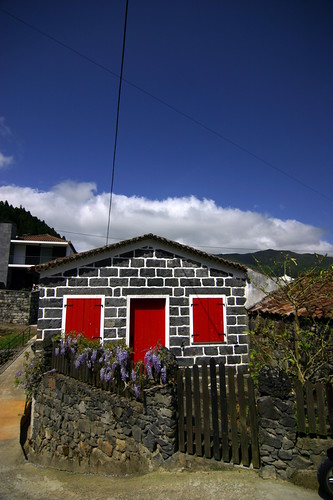Many areas of extensive volcanic activity are associated with lava tube cave formation, in the Azores they are well-developed on several of the islands.
There are two main ways these are formed, the first is a vertical shaft created where lava originally poured out. These shafts though they can be deep rarely extend to any degree laterally. The other type of cave is the result of a lava flow cooling and solidifying on the outside but the inside continuing to flow till the tube empties to some degree.

The ideal type of lava for this to occur in is the fluid pahoehoe lava, this gives rise to many beautiful formations such as uniform channels, levees, stalactites, stalagmites, lava ropes, perfect tubes and smooth floors for walking. The more viscous aa lava is also often encountered in these caves that is generally much rougher and can result in a very uneven floor to the cave. Apart from the primary lava formations we also encounter some fine secondary features, usually stalactites and stalagmites of limonite or silica.
There are lava tube caves on all the main islands (in particular Sao Miguel, Terceira, Graciosa and Pico) but the longest and the best developed for visitors is the Gruta das Torres on Pico which is over 5km. long in the Cabeco Bravo area (about 10 minutes drive from Madalena).
There will be a visitors centre at the entrance to the cave (to be completed by June 2004). The steps down to the cave floor have already been constructed using natural local shaped blocks of lava and soon some extra blocks will be used to improve the floor is in a few rougher places. The concept at all times will be to minimise human impact in the cave and preserve it virtually as it is.
The temperature in the caves is 14°C all the year round and they are basically dry and clean but during prolonged periods of heavy rain there will be drips coming down from the ceiling in a few places. Waterproofs are generally not necessary. Helmets and powerful torches will be issued where necessary and only a few key area of the cave will be illuminated by fixed lighting.
There are two main ways these are formed, the first is a vertical shaft created where lava originally poured out. These shafts though they can be deep rarely extend to any degree laterally. The other type of cave is the result of a lava flow cooling and solidifying on the outside but the inside continuing to flow till the tube empties to some degree.

The ideal type of lava for this to occur in is the fluid pahoehoe lava, this gives rise to many beautiful formations such as uniform channels, levees, stalactites, stalagmites, lava ropes, perfect tubes and smooth floors for walking. The more viscous aa lava is also often encountered in these caves that is generally much rougher and can result in a very uneven floor to the cave. Apart from the primary lava formations we also encounter some fine secondary features, usually stalactites and stalagmites of limonite or silica.
There are lava tube caves on all the main islands (in particular Sao Miguel, Terceira, Graciosa and Pico) but the longest and the best developed for visitors is the Gruta das Torres on Pico which is over 5km. long in the Cabeco Bravo area (about 10 minutes drive from Madalena).
There will be a visitors centre at the entrance to the cave (to be completed by June 2004). The steps down to the cave floor have already been constructed using natural local shaped blocks of lava and soon some extra blocks will be used to improve the floor is in a few rougher places. The concept at all times will be to minimise human impact in the cave and preserve it virtually as it is.
The temperature in the caves is 14°C all the year round and they are basically dry and clean but during prolonged periods of heavy rain there will be drips coming down from the ceiling in a few places. Waterproofs are generally not necessary. Helmets and powerful torches will be issued where necessary and only a few key area of the cave will be illuminated by fixed lighting.






No comments:
Post a Comment